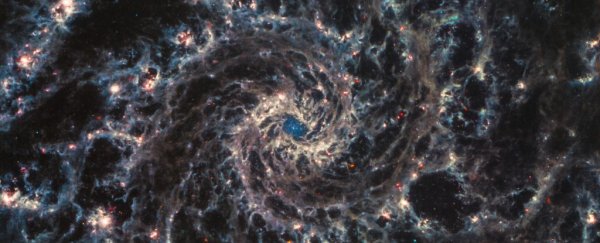It hasn't even been a fortnight since the first image release, and the James Webb Space Telescope is just continuously knocking all our socks off.
Only a few images have been officially released, but that hasn't stopped citizen scientists digging through the raw data to see what they can find.
One of those is Judy Schmidt, who has been processing raw space data into breathtaking images for years. Courtesy of her painstaking work, we now have absolutely jaw-dropping images of two spectacular spiral galaxies.
The first is NGC 628, also known as the Phantom Galaxy. The other is NGC 7496. Both are relatively close to the Milky Way, and both are the subject of ongoing observations as part of the Physics at High Angular resolution in Nearby GalaxieS (PHANGS) survey, to better chart the connections between young stars and the clouds of cold molecular gas that give birth to them.
 Webb's new image of NGC 628. (Judy Schmidt/Flickr, CC BY 2.0)
Webb's new image of NGC 628. (Judy Schmidt/Flickr, CC BY 2.0)
Contributing to PHANGS is one of Webb's early assignments, and already the images show that the newly deployed space telescope is very much worth the hype.
NGC 628 is one of the more spectacular kinds of galaxies in our sky. It's what is known as a "grand design" spiral galaxy: one with prominent, well-formed, and relatively unobscured arms. And, at just 32 million light-years away, it's close enough to provide plenty of detail for study.
 Hubble image of NGC 628 released in 2007. (NASA/ESA/Hubble Heritage (STScI/AURA)-ESA/Hubble Collaboration)
Hubble image of NGC 628 released in 2007. (NASA/ESA/Hubble Heritage (STScI/AURA)-ESA/Hubble Collaboration)
Previous observations have revealed that the galaxy's spiral arms are rich with star-forming gas seeded with young and emerging stars. Astronomers have also observed at least three supernovae in NGC 628 since the turn of the millennium.
NGC 7496, located a mere 24 million light-years away, is what is known as a barred spiral galaxy, with spiral arms extending from a distinct bar that crosses the center of the galaxy. This is thought to be the result of uneven density in the galactic disk; the denser region pulls stars towards it to create bars.
 Webb's new view of NGC 7496. (Judy Schmidt/Flickr, CC BY 2.0)
Webb's new view of NGC 7496. (Judy Schmidt/Flickr, CC BY 2.0)
These bars are thought to be regions of rich star formation as gas is channeled inward towards their centers. A beautiful barred spiral like NGC 7496 that is clearly visible is therefore an excellent laboratory for studying how stars are born.
You'll notice that Webb's images are very different from those of Hubble – and that's a good thing. The two telescopes operate in different light regimes. Hubble is primarily an optical and ultraviolet instrument, while Webb sees in infrared, which can capture light obscured by dust and gas in optical wavelengths. This means that the observations are complementary; Hubble picks up the gas, and Webb can see the newborn stars inside it.
As explained by astronomer David Thilker of Johns Hopkins University, "We're going to clearly see star clusters in the hearts of these dense molecular clouds that before we only had indirect evidence of. Webb gives us a way to look inside these 'star factories' to see the freshly assembled star clusters and measure their properties before they evolve."
 A Hubble image of NGC 7496 released earlier this year. (ESA/Hubble & NASA/J. Lee/the PHANGS-HST Team/Judy Schmidt)
A Hubble image of NGC 7496 released earlier this year. (ESA/Hubble & NASA/J. Lee/the PHANGS-HST Team/Judy Schmidt)
As you can see by comparing the images, Webb still picks up the glowing gas, but shows much more detail. In Hubble's images, the galactic nuclei are just a bright, featureless glow; Webb cuts through and shows much greater detail about what's happening in the space around the supermassive black holes around which the galaxies revolve.
We're standing at the precipice of a bold new era of space science. Already Webb seems to have identified a galaxy at a record-breaking distance, the earliest ever discovered. The papers are coming thick and fast on arXiv. Now these new images are some of the most detailed infrared views we've ever seen of spiral galaxies.
Scientists are yet to perform an analysis; we'll be waiting in hot anticipation of what Webb's data will reveal. Meanwhile, we're content to revel in the extreme pretty.
The new images are available on Schmidt's Flickr page, where you can download them in high resolution.
